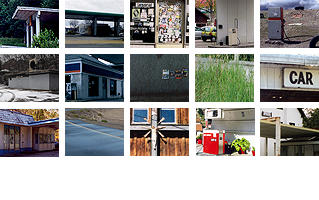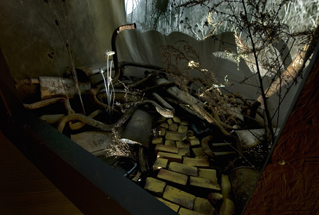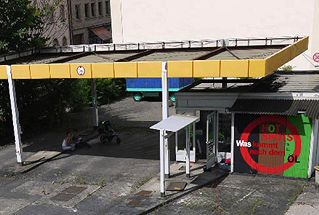HOT SPOTS: What Comes After Oil? Intent
Since the dawn of the Industrial Revolution, the Western World has become increasingly dependent on fossil fuels as the basis of our growth economy and privileged standard of living. This dependence has undermined the sustainability of all living systems and has destabilized world cultures. A paradigm shift is required to envision life-enhancing economies and wise use of our natural resources. Can we meet the challenge of renewable and responsible energy use—in our homes, communities, and across the globe?
Before change can occur, it must be imagined. Thus we have chosen the image and physical site of the petrol station—perhaps an iconic relic of future generations. Owing to their abandonment and often to their architecture, these places have a particular aura and are indicative of this worldwide politically charged question: What Comes After Oil?
Taking as points of departure are HOT SPOTS (petrol stations) in Munich, Germany; Pittsburgh, USA; and Dubai, United Arab Emirates. We have chosen these cities, local to where we live, as “case studies” for initiating a multi-national dialogue and exploration of the past, present and future of oil. Extending out from these HOT SPOTS in a radius of 200 miles/322 kilometers, we will reclaim abandoned gas stations as platforms for public art.
In addition to these primary sites, there are abandoned petrol stations all over the world. Independent of the central project, these SATELLITES will be dealt with separately by artists and artist groups. However, they will be linked with the platform HOT SPOTS.
In an attempt to reduce (and therefore re-imagine) our carbon footprint, virtual communications will be paramount. Live streaming, online papers, virtual classrooms and galleries, and the like will preserve physical resources and result in an international cacophony. Information, maps, and project programming will be disbursed through HOT SPOT offices in Munich, Pittsburgh, and Dubai and virtually on the web.
Guided by our statement of intent above, HOT-SPOTS has evolved into several projects/formats that address our primary question: What Comes After Oil? These are detailed below and include a post-oil diorama set in the Late Anthropocene era, reclamation of an abandoned gas station as a site for public art and dialogue, and an international poster and video exchange between college students in our three home countries.
Late Anthropocene: Three Continents — Pittsburgh, 2011
Late Anthropocene: Three Continents was exhibited in 2011 at the Mattress Factory Gestures 15 show, curated by Katherine Talcott, in collaboration with Ann Rosenthal and Wendy Osher, with video contributions from Hot Spots collaborators Karin Bergdolt (Germany) and Elizabeth Monoian (Dubai).
Within the frame of a ‘natural’ history diorama, Late Anthropocene: Three Continents poses a question forged from the remains of our carbon-dependent world. Traces of a yellow brick road lead to an abandoned landscape captured in Pittsburgh; Nurnberg, Germany; and Dubai. Visitors are invited to consider this historical moment where past and future converge, and the possibility for change exists.
In the mid-21st century, geologists formally agreed that a new geologic epoch, the Anthropocene, had begun. The term reflects the lasting impact humans have had on the planet, altering the course of evolution in ways that will last tens of millions of years—a distinction formerly reserved for natural geologic events, such as earthquakes or volcanic eruptions. These human impacts include habitat destruction and the introduction of invasive species, which have caused widespread extinctions; ocean acidification, which has changed the chemical makeup of the seas; and urbanization, which has vastly increased rates of sedimentation and erosion.
The term “Anthropocene” was originally coined by Paul Crutzen, who shared the 1995 Nobel Prize for discovering the effects of ozone-depleting compounds.
Click for blog entry and photos
Petrol Station HOT SPOTS Office — Nürnberg, 2010
The Nürnberg Hot Spots Office is a participatory art project as a temporary use of the abandoned gas station at the former Quelle Adam-Klein-Street/ Mendelstreet, Nürnberg. This intervention is embedded in the international art project and focuses on and asks the question "What comes after oil?"
The site has both an inside and outside space. The HOT SPOTS design (and related work) comprises the site towards the urban quarter and makes it recognizable as re-organized and alternatively used site in contrast to its former purpose. The available interior was used as an office, workshop, and showroom. Each work "What comes after oil?" was presented at the office and was open to the public through the opening hours.
The description of this HOT SPOT focuses on our use of city space, our living space and the question of how we deal with our resources, i.e., our living context. A variety of presentations/ work was planned in which artists were asked to participate.Photos from HOT SPOTS office (PDF)
Artikel Kreisbote
Einmal auftanken, bitte
Click here for PDF brochure in German
International Student Poster & Video Exchange — Dubai, Pittsburgh, Munich, 2009-2010
The principal team of HOT SPOTS: What Comes After Oil? has initiated a poster and video exchange amongst international college students. These exchanges are an opportunity for students to participate in an international dialogue on the social, political, economic, and environmental ramifications of the impending 21st century transition from fossil fuels to more sustainable forms of clean energy.
The value of this project is to highlight the different thought processes that are born of the experiences and backgrounds of students from varying parts of the world. The platform from which these thoughts arise is unique to each place and situation despite the fact that the principles and facts that underlie the discourse are the same (i.e. the inevitable end of oil). The conversation that is the result of these exchanges are made more valuable in that they allow complex developed visual ideas to be traded in a tangible way but at the speed of virtual communication.
For the poster exchange, students from American University in Dubai, Zayed University (Dubai), the Art Institute of Pittsburgh, and the University of Applied Sciences (Munich) have designed close to 100 posters, which have been exhibited in several venues in our three countries and online (see our Events page for details). The poster exhibition premiered at the Art Institute of Pittsburgh for the G20 Summit, and the posters were concurrently shown at the jamjar Gallery in Dubai.
Please click here to visit our Facebook page filled with images of the posters, text written by the students, and photos of the exhibition openings.
Click here for PDF presentation of posters from 2009. (16MB)
Click here for PDF catalogue from the Hochschule Munich exhibit. Organized by Wolfgang Gebhard (19MB)
For the video exchange, students from American University in Dubai and the Art Institute of Pittsburgh developed audiovisual messages of no more than three minutes on the theme “Oil: A Non Renewable Resource.” The video exchange was initiated later than the poster exchange and thus has been less extensive so far. We welcome additions to this exchange!
Click here to see video projects by American University in Dubai students
Click here to see video projects by Art Institute of Pittsburgh students






